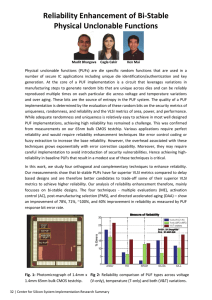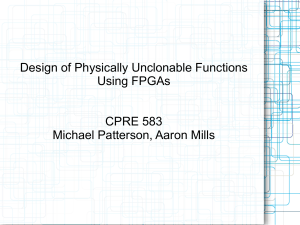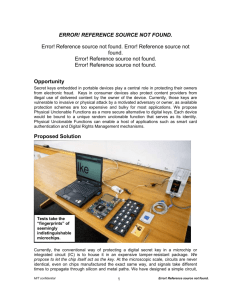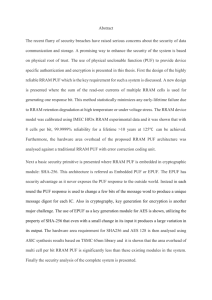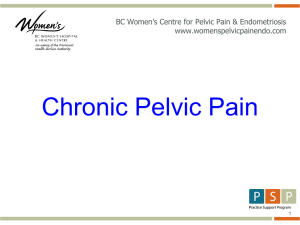Case Study in Chronic Pelvic Pain
advertisement
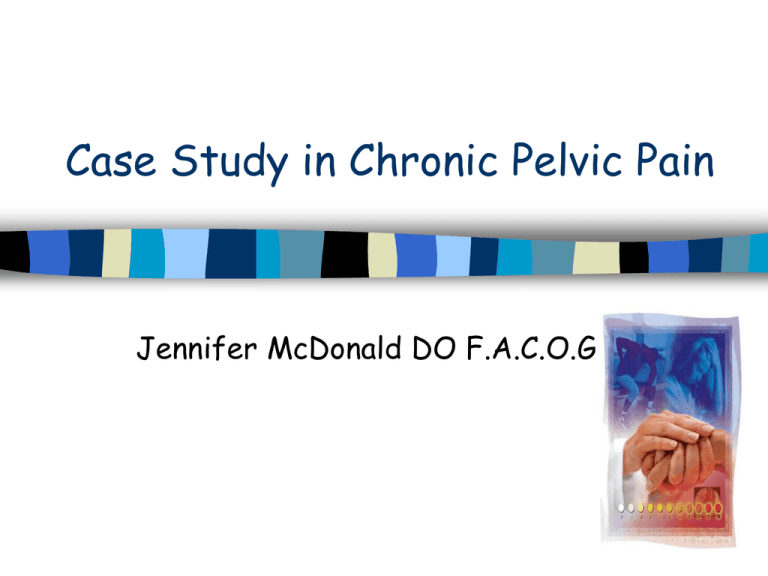
Case Study in Chronic Pelvic Pain Jennifer McDonald DO F.A.C.O.G 61% of CPP will have no definitive diagnosis !! Definition of Chronic Pelvic Pain (CPP) Non-cyclic 6 months or more in duration Localized to pelvis, anterior abdominal wall below the umbilicus, lumbosacral area, or buttocks Causes significant enough impairment to cause them to seek treatment Case C.A. is a 26 year old white female who has been treated 12 times in the last two years for recurrent urinary tract infections. She presents with symptoms of urinary frequency, urgency, pelvic pain, and dyspaurenia. She also describes alternating diarrhea and constipation especially around the time of her menstrual cycle. She reports she is in a long term, monogamous relationship but is afraid to commit to marriage as her problem with painful intercourse is worsening. She admits that she voids 18-20 times per day and awakens 3-5 times each night. She is a non-smoker and her menstrual cycles are painful but regular. Important Questions for CPP patients Where is your pain? When did it start? What makes it better? What makes it worse? Are your cycles painful? Pain with urination? Frequency? Is intercourse painful? Do you have pain in other parts of your body? What diagnostic studies have been done? What were the results? What treatments have been tried? How successfully? How do you sleep? How is your family life? Job? Any bowel symptoms? Have you seen other doctors? Physical Exam C.A. is a healthy appearing female who is height/weight appropriate Supra-pubic and perineal tenderness as well as tenderness across the bladder base No evidence of vaginitis or a sexually transmitted disease Where do we look? Gynecologic - extra-uterine Gynecologic - uterine Urologic Musculoskeletal Gastrointestinal Neurologic Pelvic Pain Assessment www.reliefinsite.com www.pelvicpain.org Lab Evaluation Urinalysis • Nitrite negative • Leukocyte esterase negative • Trace blood • Bilirubin negative Urine Culture • No organisms Cystoscopy/ Hydro-distension (Not always necessary) C.A. has Interstitial Cystitis CPP syndrome of bladder origin estimated to affect as many as 1 in 4.5 women Often misdiagnosed as endometriosis, recurrent UTI’s, or overactive bladder Typically white women of reproductive age (90%) Symptoms first noticed in their 30s but usually a delay of 5-8 years before accurate diagnosis making average age 42-46 Women have consulted 5-8 healthcare professionals before receiving a correct diagnosis Pathogenesis of IC K+ and Urea GAG Layer Irritated Nerves Identifying Patients Is Important A New Screening Questionnaire for Pelvic Pain and Urgency/Frequency (PUF) PUF Screening Circle the answer that best describes how you feel for each question. 0 1 2 3 4 1 How many times do you void during waking hours? 3-6 7-10 11-14 15-19 20+ 2 a. How many times do you void at night? 0 1 2 3 4+ None Mild Moderate Severe Never Occasionally Usually Always Never Occasionally Usually Always 5 Do you have pain associated with your bladder or in your pelvis, vagina, lower abdomen, urethra, perineum, testes, or scrotum? Never Occasionally Usually Always 6 Do you still have urgency shortly after urinating? Never Occasionally Usually Always Moderate Severe Usually Always Moderate Severe Usually Always b. If you get up at night to void, to what extent does it usually bother you? 3 Symptom Bother Score Score > 10 points 74% likelihood of IC Are you currently sexually active? YES _____ NO_____ 4 a. If you are sexually active, do you now have or have you ever had pain or urgency to urinate during or after sexual intercourse? b. Has pain or urgency ever made you avoid sexual intercourse? 7 a. When you have pain, is it usually—? b. How often does your pain bother you? 8 a. When you have urgency, is it usually—? b. How often does your urgency bother you? Mild Never Occasionally Mild Never Occasionally 5-10 points 55% likelihood of IC Healthy women < 2 points SYMPTOM SCORE (1, 2a, 4a, 5, 6, 7a, 8a) BOTHER SCORE (2b, 4b, 7b, 8b) TOTAL SCORE (Symptom Score + Bother Score) = PUF PUF isisaa constellation constellationofof symptoms symptoms identified identified by by ICIC experts experts as as characteristic characteristic ofof interstitial interstitial cystitis. cystitis. The The more more symptoms symptoms aapatient patient experiences, experiences, the the more more likely likely itit isis that that they’re they’re caused caused by by interstitial interstitial cystitis. cystitis. Parsons 2000 1 C.A.’s PUF = 18 Potassium Sensitivity Test (PST) 80% patients with IC have a +PST Instillation of 40mL of room temperature sterile water. Pain rated 0-5 Water removed after 5 minutes and replaced with 40 mL of KCl. Pain re-evaluated Any increase of 2 or more points is a + result • 91% patients with PUF > 20 will have + PST • 76% patients with PUF 15-19 • 55% of patients with PUF 5-9 • Allows us to reserve PST for women with suggestive symptoms but lower PUF scores Obstacles to Diagnosis IC relatively “new” or at least newly understood Definition of IC not uniformly agreed upon Lack of education in medical profession No definitive test Often misdiagnosed for long periods because of overlapping symptom complex Variation in severity of symptoms Treatments • Elmiron only drug FDA approved for treatment • Resembles naturally occurring GAGs • Reduces painful symptoms • 2 to 4 months women with mild disease and 6-12 months in women with severe disease Non-Pharmacologic Treatment Dietary manipulation is mandatory Alcohol Apples Bananas Citrus fruits Coffee Carbonated beverages Chocolate Mayonnaise Most nuts Pineapple Onions Soy sauce Yogurt Sour cream Beans • Chiropractic care • Biofeedback/Bladder training • Pelvic floor relaxation exercises Keys to Treatment Pain and its perception are located in the nervous system so its treatment must encompass a Mind and Body approach Multiple interactive problems are most likely with CPP so it isn’t which treatment is best but which treatments It usually took time for things to get to where they are so it will be take time to get them back to normal as well Chronic pain affects a family not just an individual patient The patient with CPP needs a multidisciplinary approach … are you ready?
